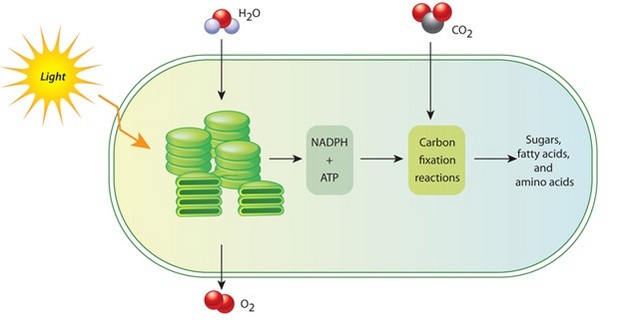In Light Reactions Light Energy Is Used to Oxidize
The electrons derived from this oxidation reaction in the light reactions are used to reduce ____ to _____. The light reaction takes place in the thylakoid discs.

The Light And Dark Reactions In The Chloroplast Learn Science At Scitable
The reaction center contains a pair of chlorophyll a molecules with a special property.

. The NADPH and ATP produced are subsequently used to power the sugar-producing Calvin cycle. Photosynthesis is a light-driven oxidation-reduction reaction where the energy from the light is used to oxidize water releasing oxygen gas and hydrogen ions followed by the transfer of electrons to carbon dioxide reducing it to organic molecules. The absorption of light excites the pigment to a higher energy state.
The energy formed in the light reactions of photosynthesis is used to convert carbon dioxide into glucose during the Calvin cycle dark reactions. Chlorophyll absorbs the red and blue segment of the white light and photosynthesis occurs most efficiently at these wavelengths. Two types of reaction centers exist generally called Photosystem I PSI and.
There water H 2 0 is oxidized and oxygen O 2 is released. Some light energy is used to convert ADP to ATP. In the light reactions the energy of sunlight is used to oxidize water the electron donor to O2 and pass these electrons to NADP producing NADPH.
The Steps Involved in the Light Reaction. The electrons derived from this oxidation reaction in the light reactions are used to reduce NADP to NADPH. 2A2 The light-independent reactions of photosynthesis in eukaryotes involve a series of reactions that capture free energy present in light.
When the photochemical pathway is backed up eg when incident light energy absorption exceeds the capacity for use of reducing equivalents in the dark reactions there is a danger that the excited state can decay via undesirable routes. This process takes place in the thylakoid membrane which includes the two photosystems shown above. The main purpose of the light reaction is to generate organic energy molecules such as ATP and NADPH which are needed for the subsequent dark reaction.
The Calvin cycle oxidizes the light-reactions product to co 02 4. The Calvin cycle oxidizes the light reactions product. Some light energy is used to convert ADP to ATP.
In the presence of electron donors such as a reduced dye a second type of lamellar particle can absorb light and transfer electrons from the electron donor to ferredoxin. Those two chlorophylls can undergo oxidation upon excitation. The light-dependent reactions use light energy to make two molecules needed for the next stage of photosynthesis.
Some light energy is used to convert ADP to ATP. Up to 24 cash back Definition. In the light reactions the energy of sunlight is used to oxidize water the electron donor to O2 and pass these electrons to NADP producing NADPH.
In the light reactions light energy is used to oxidize to ATP 2. Some light energy is used to convert ADP to ATP. They can actually give up an electron in a process called a photoact.
As mention earlier the light reactions take place in the thylakoid membranes of chloroplasts. In plants the light reactions take place in the thylakoid membranes of. Energy captured from light by chlorophyll and its accessory pigments drives the production of ATP.
Light-dependent reactions are the set of reactions of photosynthesis in which light energy excites electrons in chlorophyll molecules powers ATP synthesis and results in the reduction of NADP to NADPH. The energy storage molecule ATP and the reduced electron carrier NADPH. One type of particle can absorb light energy oxidize water and produce oxygen light reaction II but a special dye molecule must be supplied to accept the electrons.
The photosynthetic scheme begins when the pigments of the light harvesting complex absorb a photon of visible light. O2 ATP NADPH. Photosystem II is first and photosystem I happens second.
In the light reactions light energy is used to oxidize ______ to ______. In the light reactions the energy of sunlight is used to oxidize water the electron donor to O2 and pass these electrons to NADP producing NADPH. Science Practice 14 The student can use representations and models to analyze situations or solve problems qualitatively and.
The electrons derived from this oxidation reaction in the Calvin cycle are used to reduce CO2 to G3P. In the light reactions light energy is used to oxidize H2O to O2. The NADPH and ATP produced are subsequently.
The NADPH and ATP produced are subsequently. It is at this step in the reaction center that light energy is converted into an excited electron. Therefore protective mechanisms collectively referred to as nonphotochemical quenching NPQ are built.
The electrons derived from this oxidation reaction in the light reactions are used ADP to reduce to 3. The pigments transfer their excitation energy to the reaction center chlorophyll molecule. The electrons freed up from water are transfered to ATP and NADPH.
In the light reactions the energy of sunlight is used to oxidize water the electron donor to O2 and pass these electrons to NADP producing NADPH. The Calvin cycle oxidizes the light-reactions product NADPH to NADP. The NADPH and ATP produced are subsequently used to.
Definition of Light-dependent Reaction.

Solved Drag The Terms To The Appropriate Blanks To Complete Chegg Com

Light Dependent Reactions Photosynthesis Reaction Article Khan Academy

Solved In Photosynthesis A Redox Compound That Is Produced Chegg Com
Comments
Post a Comment